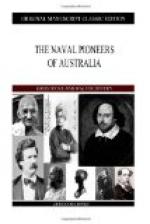There were ninety-nine survivors, divided between four boats, and they had 1000 miles to voyage. They landed at Coupang on September 19th, after undergoing the greatest suffering, aggravated in the case of the prisoners by the most wanton cruelty on the part of Edwards. From here they were sent to England for trial, arriving at Spithead on June 19th, 1792, four years and four months after they had left in the Bounty, of which time these poor prisoners had spent fifteen months in irons. In the following September the accused were tried by court-martial at Portsmouth Harbour. Bligh was away on his second breadfruit voyage, but he had left behind him as much evidence as he could collect that would be likely to secure conviction, and one of the officers so backed up his statements that young Heywood, a boy of fifteen, be it remembered, came near to being hanged. Bligh’s suppression of facts which would have proved that the youngsters Stewart and Heywood were mere spectators at the worst of the mutiny, Sir John Barrow suggests, has “the appearance of a deliberate act of malice.”
The result of the trial was the just acquittal of four of the petty officers and seamen, the conviction of Heywood, of Morrison, boatswain’s mate (a man of education, who had kept a diary of the whole business), and of four seamen. Three of these last, one of them seventeen years of age at the time of the mutiny, were hanged in Portsmouth [Sidenote: 1807] Harbour. Heywood, Morrison, and a seaman named Muspratt were pardoned. It was plain that the authorities recognized the innocence of these men, for Heywood made a fresh start in the service, and served with distinction, dying a post-captain in 1831, and Morrison was drowned in the Blenheim, of which ship he was gunner when she foundered off the island of Rodriguez in 1807.
What had become of the Bounty? In March, 1809, there reached the Admiralty an extract from the log of an American whaler, commanded by Matthew Folger. This extract showed the Pitcairn Island, hitherto scarcely known and supposed to be uninhabited, had been visited by the whaler, which found thereon a white man and several half-caste families. The man was the sole survivor of the Bounty mutineers, and the half-caste families were the descendants of the others by their Tahitian wives. In proof of his statements, Folger brought away with him the chronometer and azimuth compass of the Bounty. War was then going on, and England paid little attention to the news, until in September, 1814, two frigates, the Briton and the Tagus, visited Pitcairn, when the end of the Bounty story was told to the commander by the sole survivor.
When the Bounty left Tahiti, Christian took with him Young, a midshipman; Mills, gunner’s mate; Brown, one of the two botanists; and Martin, McCoy, Williams, Quintall, and Smith, seamen. These men were accompanied by five male islanders from Tahiti and Tubuai (in which last place they had attempted to form a settlement and failed), three Tahitian women, wives of the Tahitians, and ten other Tahitian women and a child.




